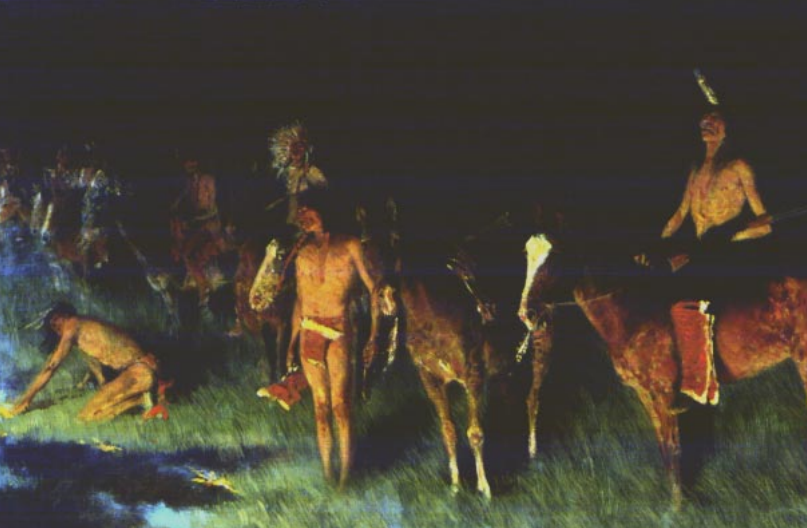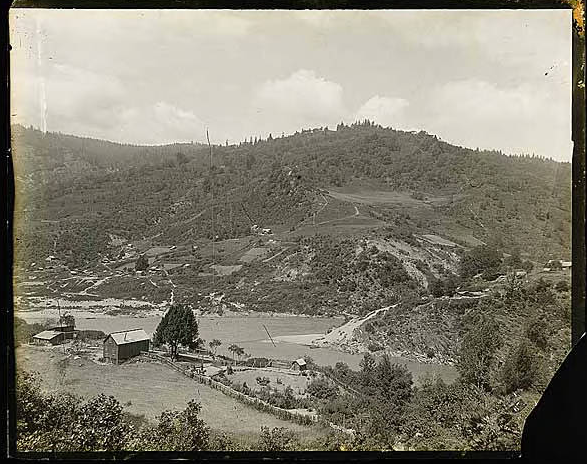The Past and Future of Prescribed Fire
- Kenny Slocum

- Apr 2, 2024
- 7 min read
This time of year I tend to get pretty one track minded. I obsessively check and re-check the weather forecasts, looking at the humidity predictions and wind directions, trying to see when and where we’ll have nature’s blessing to light a match and carry fire through the natural areas that need it most.
Each fire season, I rekindle my relationship with the deep human history of fire, wondering what the ancient peoples felt about the creative and destructive potential of each spark they harnessed to cook food, clear land for agriculture, signal to distant cohorts, or drive away encroaching enemies.
Captured in mythos and spiritual storytelling throughout the world, humanity’s ability to control fire arguably represents one of the greatest leaps in evolutionary history among all the creatures to have ever walked, swam, or slithered across this planet.
For most of our history as a species, fire has been the only elemental force over which we could exert any control. We can do little about the rain or the wind. Until the Haber process allowed us to harness atmospheric nitrogen, we could do little to change the soil – except alter the ash and carbon content through fire.
Perhaps by accident, nearly every ancient culture discovered the utility of fire to do in a day what would take weeks by axe or plow. Observations over hundreds or thousands of years allowed these ancient practitioners to figure out what kinds of fires benefitted what – a spring fire here to enhance summer berry foraging, a fall fire there to concentrate game species in a favorable hunting ground over the winter.
Over time, in much of the United States, European settlers systematically eradicated indigenous knowledge and practices. Some of this stems from heritage: Germans in particular had a dislike of fire, ardently stamping out any wild blaze in their valuable timbers. Their descendants in the United States followed suit.
Other parts of it stem from the deep-seated racism against Native Americans, dismissing low-intensity burns as “Paiute Forestry,” a kind of barbarism and disrespect for natural resources that had no place in the enlightened textbooks of Western Science. Of course, the early 20th century and the intense, destructive, deadly wildfires borne of decades of fuel buildup turned that idea on its head rather quickly.
Unfortunately, by then, much of the indigenous knowledge surrounding “light fires” had already gone up in smoke.
Today, ecologists can piece together a blurry, impressionistic picture of historic and pre-historic fire regimes. In places where trees live a long time, we can examine tree rings to determine fire severity and frequency. We can look at ash deposits in the soil layers. We can look at current vegetation composition: lots of fire-dependent species probably means a site burned pretty regularly.
The great plains in particular present quite a challenge given the absence of trees and the history-recording rings therein. Compared to woodlands, prairie burns leave a pretty thin ash layer that's difficult to detect. We can only assume given the plains' extent, and the rapidity with which these sites become encroached by forest, that they must have burned a lot more frequently than lightning alone would ignite.
But anyone who has seen a good prairie fire can attest that even modern technology makes controlling such fires a challenge. Today, we have engines and bladder bags and propane torches and flappers and maps and weather predictions. Failing all that, we have roads and green lawns to stop most fires from running freely across the countryside.
So how on earth did indigenous people on the endless plains do “controlled” burns without any of the modern conveniences?
We do have some scant journal writings from early European settlement that can answer at least some of these questions. Lewis and Clark spoke of one celebration where, to bless their journey, a local tribal elder held torch of cured grasses up to pine tree which promptly burst into flames, akin to a fireworks display.
We also have to remember how incredibly different pre-Columbian America looked, and how differently those people lived.
Frequent fires allowed for minimal fuel buildup. In pine country, low-severity fires can kill young white or red pine trees, but the survivors would heal over their scars with even thicker, more flame-resistant bark. More open woodlands also allowed those trees to grow taller, putting their needles out of reach of ground fires and reducing the likelihood of stand-destroying crown fire running through the canopy.
Plains tribes were particularly mobile, following game seasonally in easily moveable encampments. They could set up camp along a sandy riverbank, or on a bison grazing lawn during the flammable season and enjoy a reasonable sense of security from fires both natural and anthropogenic.
For the unexpected, tribes were not completely bereft of control measures. A wet bison hide is not so different from a flapper. For that matter, it makes a decent fire shelter if you're got in a bad spot. A bison scapula fitted to a stick is not dissimilar to the pulaskis and mcleods used today to dig fire lines.
One particular interesting account from the Texas panhandle tells of how native peoples could lay a “wet line,” a strip of wet vegetation meant to halt advancing flames. Warning: the following story is a little gross.
Bison or cattle have plenty of fluid inside. So, after cutting an animal open, two men on horseback could drag the carcass along the intended control line and effectively create a buffer of flame-resistant vegetation around sensitive areas in advance of a coming fire, or drag the carcass along the firey front to smother the flames if a burn needed extinguished.
But more commonly, early peoples fought fire with fire. Burn here in the fall, set up camp on the thin, green grass in the spring, burn it again if necessary, before too much fuel builds up, and voila. Kinda like mowing the lawn, but way more fun. In other words, pre-Columbian people created what we now call “defensible space," keeping the fire out rather than trying to hem it in.
Then as now, timing was everything in practicing “good” fire. Peoples of the northwest fastidiously lit their meadows on fire in the fall, when frequent rains meant the adjacent woodlands would hold too much moisture to spread. Midwestern tribes worked opposite the Northwestern groups, utilizing spring rains to minimize fire intensity and longevity.
Tribes in the southeast, seemingly, burned whenever they possibly could, up to twice a year when conditions permitted. Like all people, they had a multitude of reasons for starting fires, but it primarily served to create pasture ground for wild game. The first European settlers to the region came largely from Western England and Scotland, which had an existing culture of fire as pasture management.
The Europeans quickly adapted their practices alongside some tutelage from the native peoples, and unlike the fenced properties of the Northeast, allowed free range of cattle and pigs, who filled the niche of elk and bison to further maintain shorter vegetation and prevent large-scale fires. Today the Southeast is arguably the only place in America with an unbroken culture of intentional fire spanning from the ancient past to the present day. And so in the mid 20th century, when the alphabet agencies started to realize that the “10 AM policy" presented significant hazards to human and forest health, they looked to those old traditions.
The first prescribed burning programs by federal agencies took place in the 1930’s on Longleaf Pine stands in the southeast, pioneered by Herbert L. Stoddard. Stoddard was employed by the U.S. Bureau of Biological Survey (a precursor to the Fish & Wildlife Service) to determine the reason for Bobwhite Quail population declines.
He determined that fire suppression had altered their habitats, and advocated tirelessly for the application of “winter fires” to promote Bobwhite habitat. Stoddard would go on to create the Tall Timbers Research Station in Florida in 1958 specifically to study fire ecology. That institute today provides some of the most in-depth research on fire effects in systems far beyond the Florida flatwoods.
We have done well to return fire to the ecosystems that need it, but through research at Tall Timbers, or the Konza Prairie Research Station in Kansas, or our own Conard Environmental Research Area outside of Grinnell, one point shines through: we can return fire, but we cannot go back in time.
We can look at historic fire intervals, but they can only tell us how we got here. They can’t tell us how to get where we want to go. They have limited value in a landscape without wild grazers, a landscape rife with invasive species, and an altered climate affecting which plants grow when. We can, however, look to those old practitioners for guidance on how to approach the future.
Fire, historically, was a community affair. Neighbors helped each other burn. People recognized that fire improved the health of the “commons” they all shared, be it pasture or hunting grounds or berry thickets. They recognized collectively when a burn was needed, and got it done. They didn’t arbitrarily burn every three years because “that’s how often they need it.” (My biggest pet peeve – prairies don't have calendars. Have a goal, people!)
In a place like Iowa, with the vast majority of land in private hands, we need a return to that neighborly approach. I’ll never forget speaking to Brian Fankhauser from Iowa Natural Heritage Foundation about the difference between Northeast Iowa’s fire culture and the massive, 1000+ acre multi-jurisdictional burns practiced in the Loess Hills.
“I’d always rather burn a really big unit with lots of people than try to keep those 3-acre jobs within the lines.” To be clear, there are often good reasons to keep a burn unit small – if those walnut trees are your retirement fund, you might not want to let fire run freely through those woods just because it’s a little easier. If it’s the only prairie for miles around, you want to leave some unburned patches for insects to repopulate when the growth returns.
But a lot of stress and anxiety can be abated by just talking to your neighbor. Maybe they’ve wanted to try a fire in their oak woodland, but they’ve been scared of it getting onto your adjacent CRP. Maybe they were planning on burning next year, but since you’re doing it, they can get their supplies together and make a day of it. If nothing else, maybe they ask how and why you’re doing it, and down the road they’re better equipped to steward their own land. We’ve learned a lot these last few years just by going out on burns with partner orgs. Everyone does things a little differently, and everyone has slightly different reasons for burning one site and not another.
One can spend a lifetime reading the literature on the how, when, and why of burning, but none of that can replace the intimate knowledge landowners have of their own land. The more we can share that knowledge with our friends and neighbors, the better off that land will be for our children and grandchildren.














For serious nursing essay help, look no further than https://www.nursingpaper.com/our-services/nursing-essay-writing-service/. They deliver on time, cite sources correctly, and understand APA formatting like pros. Totally worth it.